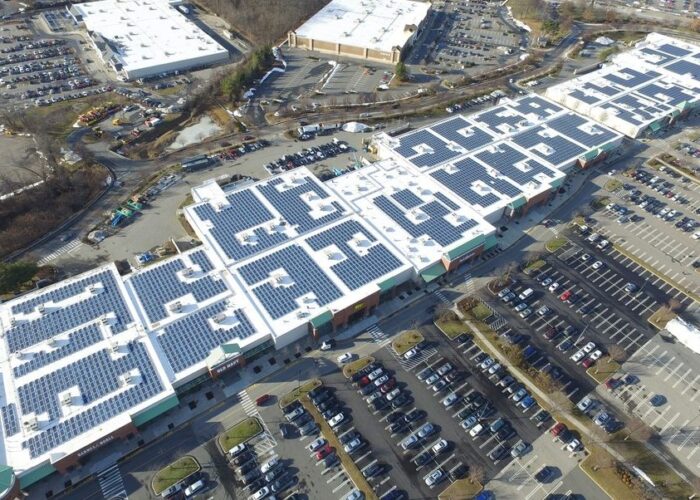
Growing 43% year over year in 2016, the US solar industry is taking off at a pace no one could have foreseen. Naysayers may cite the industry’s slow start, hampered by high upfront costs and initial niche appeal as reasons why solar still will not experience a consumer boom. But panellists at the opening session of the 13th annual Solar Power International convention made it clear just how solar energy could exceed expectations and is poised for not only growth, but mainstream acceptance.
Try Premium for just $1
- Full premium access for the first month at only $1
- Converts to an annual rate after 30 days unless cancelled
- Cancel anytime during the trial period
Premium Benefits
- Expert industry analysis and interviews
- Digital access to PV Tech Power journal
- Exclusive event discounts
Or get the full Premium subscription right away
Or continue reading this article for free
1. Increased deployment
“Regardless of where the data has come from, people linearly extrapolate from a small number and after 40 years get another smaller number, but there is such a thing as exponential growth and I think the solar industry is on the cusp of that,” said David Crane, former NRG Energy executive and newly-installed senior operating executive at private equity firm Pegasus Capital Advisors.
The latest report by GTM Research and the Solar Energy Industry Association (SEIA) detailed how US solar is embarking on an unprecedented wave of growth, and this is evidenced by Steve Malnight senior vice president, regulatory affairs at Pacific Gas and Electric Company (PG&E) forecasting all growth in energy consumption in leading solar state California to be met by distributed generation by 2024.
2. Overcoming rookie mistakes
In hindsight, the US solar industry made a few schoolboy errors in getting off the ground, but, according to Crane, it “did what it had to do” to get started. Yes, a lot of the time it was not price competitive, and in retrospect, too many companies went public too early he said. Crane also emphasised the disdain of the public market in regards to anything unpredicatable; including lurches in strategy and exponential growth that are hallmarks of the US solar industry. However, despite predictability being hard to come by, solar overcame this and still presents an enormous opportunity for private equity markets in particular.
In addition, according to Malnight, the industry would have been better off had utilities and the industry at large embraced the phenomenon of exponential growth and abstained from “myopic” and “short-term” visions.
3. Growing from a small base
An analogy by Spruce’s Nat Kreamer compared the solar industry to the automotive industry circa 1921; lacking in a clear business model and with consumer desires unclear. GM even nearly went bankrupt but as is clear, “cut-throat” consolidation did happen with cars and is set to happen with solar. “We haven’t looked outside ourselves as to where we sit in the value chain, but we have a bright future and we are ‘going to sell a lot of cars,’” said Kreamer.
Conversely, Crane contrasted solar with the mobile phone industry in 1990. “With the cell phone it was immediately apparent that people wanted it,” said Crane. “That is the gap solar has not overcome yet.” The challenge that solar still has yet to face is breakthrough into the mass population. But it is worth noting, as Crane did, that smartphone penetration was only at 1% in 2004, but catapulted to 100% just six years later.
“I know why I want the next iPhone, but does the average person know why they want solar?” Perhaps not. However, part of that key increased penetration is changing the minds of the populous on things other than cost and basic reliability. Most are in agreement that a solar panel is never going to achieve that “emotional attachment” that is attainable with an iPhone, but that is ok.
“We shouldn’t focus on solar as the iPhone – it’s not going to be the iPhone – but it is going to enable us to do more and do it guilt free. I think there is a great opportunity for that,” said Malnight. Especially when packaged as a ‘solar-plus’ integrated system with other components such as energy storage and demand response, the value proposition for solar might only get stronger.
4. Developing more sophisticated business models
Panel moderator Jeff Ball, from Stanford University, highlighted how there is a very real potential for solar to reach a terawatt of global capacity, if the current trend continues of adding roughly 50GW of capacity a year. In order for this to be a tangible proposition, Kreamer argued that the key lies in investment.
“Invest in what is economical; if you are in a business that should consolidate in scale, make sure you are a catalyst for that,” he explained.
Although the US lacks private energy as a dominant force unlike energy development in other economies, the unique public-private partnership presents an opportunity to use policy to shape the industry. “Not enough people invest in policy like they do in the wind industry,” warned Kreamer.
“There is a societal good that can be done through solar and new technology. Policy is on a federal level with incentives but it is also very local. There are a lot of states in the country that are nervous to go higher than 1% with solar. We need to start ‘building some roads’”, said Malnight, returning to the automotive analogy.
Crane echoed this thought, calling on the industry to be unified and not get depressed. “With the election and change in Administration in November it is now not just about looking to pass an investment tax credit, it is about looking at things and making them part of society in the future.”






